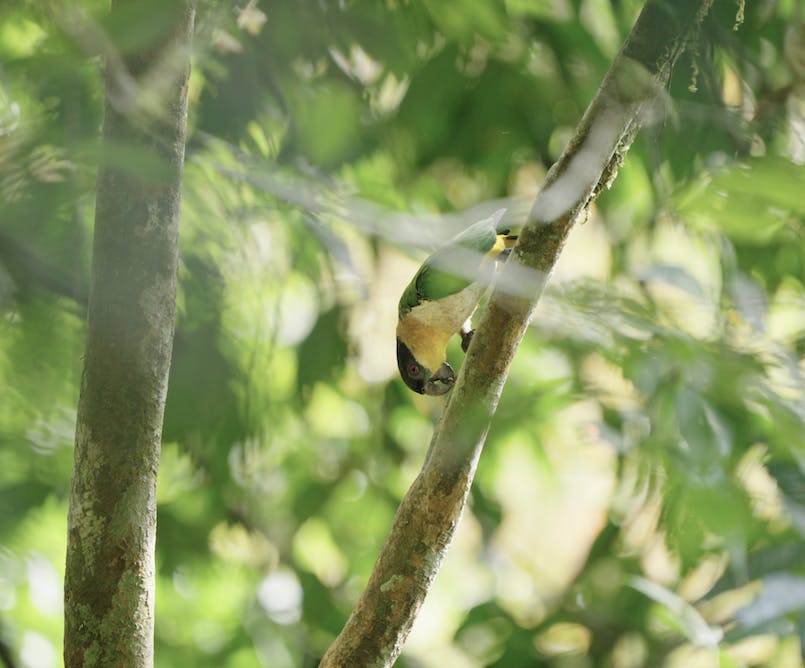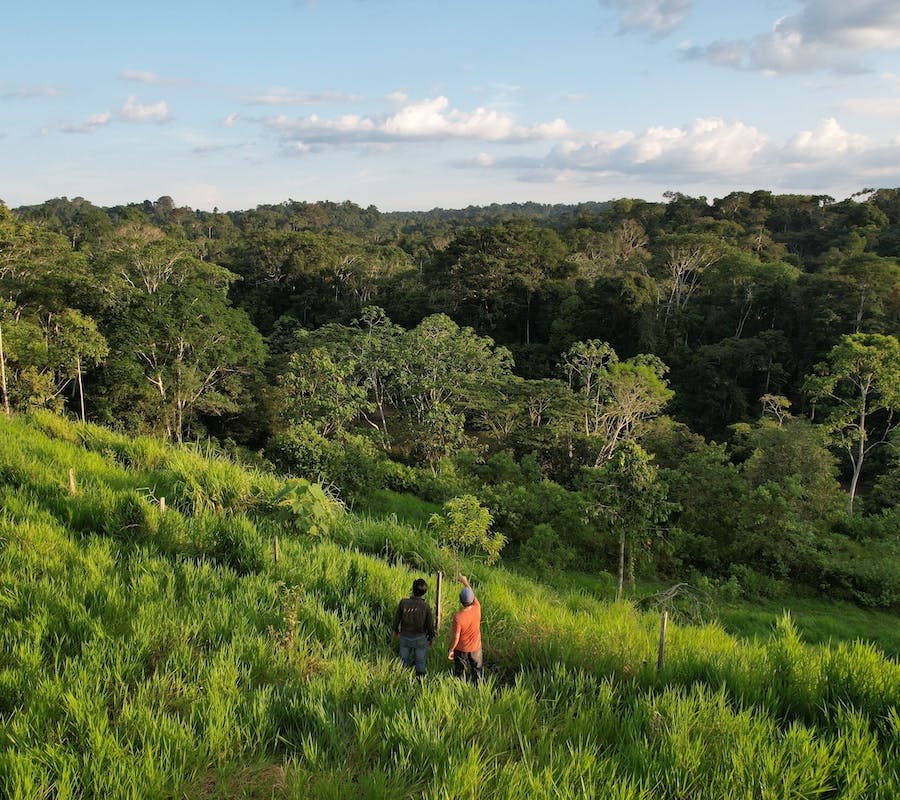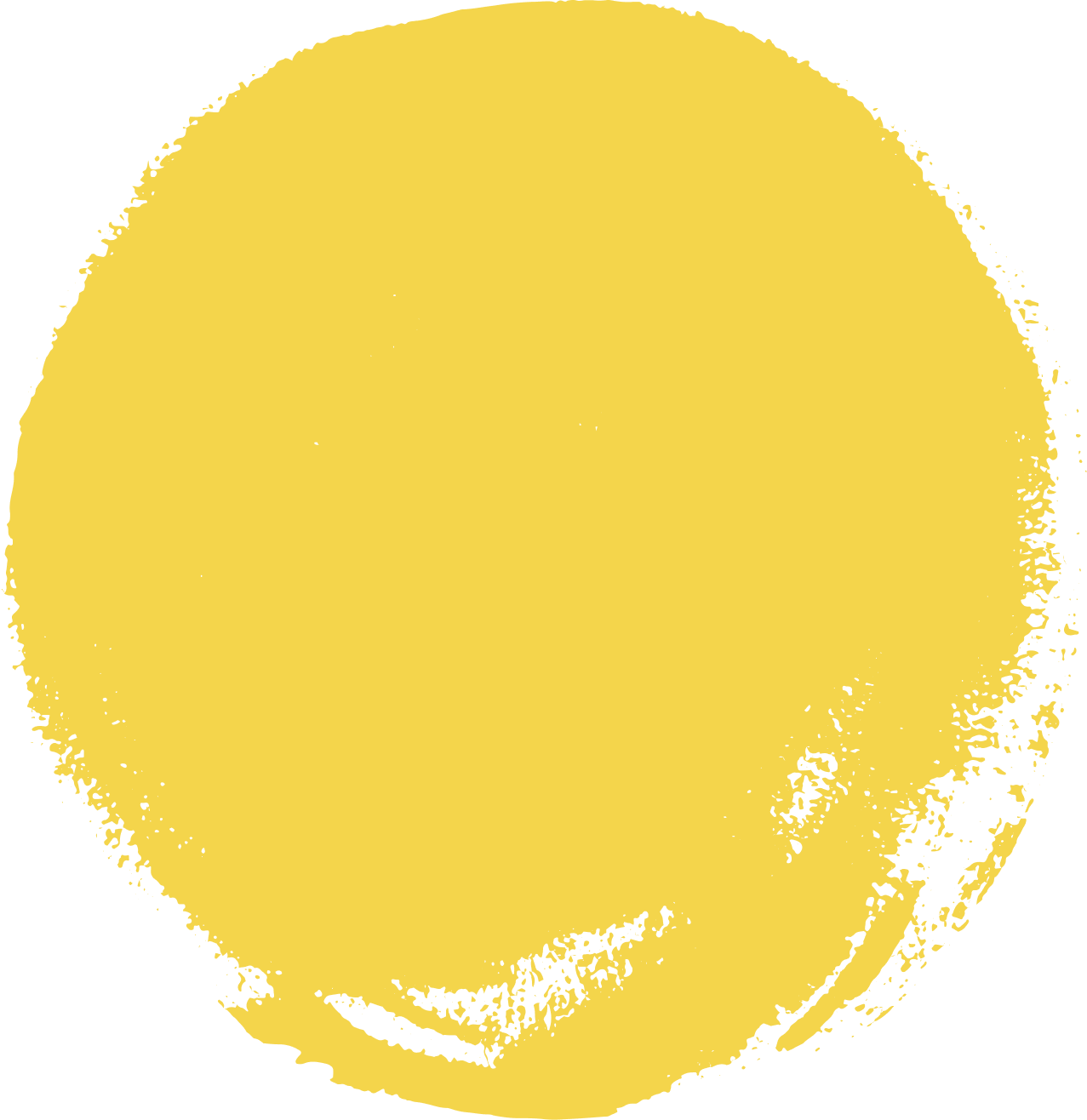- Status: In Progress
We are embarking on a new journey. To help protect the most biodiverse place on Earth.
Our new project, led by our own team of biologists, will aim to protect and restore rainforest in the buffer zone of the Yasuní National Park. Located in the Amazon region of Ecuador, this rainforest is home to the highest concentration of species on the planet.
We have laid the cornerstone by purchasing 209 hectares of forest that borders the national park, securing its protection and establishing a base for our project. Together with members of the local community and local experts, we will develop solutions to stop forest degradation and kick-start forest regeneration in the area.
Project Timeline
March 2025-April 2025
Installing canopy bridges for arboreal animals and implementing tree islands to speed up rainforest regeneration.
February 2025
Volunteer programme and Young Birdwatchers of Yasuní club kick off.
The Pinnacle of Biodiversity
The Amazon is the world’s largest and most important tropical rainforest. Its vastness is difficult to grasp and its wilderness has captured the imagination of generations of people across the world. It hosts the greatest diversity of life on the planet, much of which is still unknown to science.
Yet still, within its 5.5 million square kilometres, one region stands out above all. A belt of rainforest in the eastern Amazon that runs from the lowlands of Ecuador to Iquitos in Peru. Here, the highest levels of biodiversity for mammals, birds, amphibians and vascular plants overlap to form a planetary megadiversity hotspot.

The Yasuní National Park
Nestled within this belt lies one protected area, the Yasuní National Park, which is often anecdotally referred to as the most biologically diverse place on the planet.
Yasuní tops the list for amphibian diversity with a record 150 species documented to date. It's home to over 200 mammal species, 12 of which are primates, a count that rivals the richest primate regions of Africa. Even more astounding are the numbers for insects and plants. A single hectare of forest in Yasuní is projected to contain at least 100,000 insect species, the highest estimated biodiversity per unit area in the world for any taxonomic group. For plants, Yasuní holds three world records in diversity measures for woody plant species and is one of the 9 global centres for plant diversity.
At the local scale, Yasuní protects the richest area in the world of woody plant species. Studies suggest that a typical hectare of terra firme forest in Yasuní contains upwards of 655 tree species - more than are native to the continental United States and Canada combined! Although multiple research projects have been conducted here, the reality is that very little of the park has actually been studied.
If you want to dive deeper into the research on Yasuni’s astounding species richness, we recommend starting with this article.

Noah’s arc for biodiversity in a changing climate
It is still unknown exactly why Yasuní is so diverse. Its species richness is likely the result of the unique conditions found at the intersection of three distinct ecological systems: the Andes, the Amazon, and the Equator that foster ever-wet and ever-warm conditions and relatively aseasonal climate. This seasonality, resulting in year-round availability of fruit and flowers, may be an important factor in the park's exceptional number of coexisting birds and mammals and the overall high animal biomass.
Another explanation for Yasuni's extraordinary diversity comes from the past. Some studies suggest that it was here that a pocket of the tropical rainforest survived the last ice age and from where species spread across the Amazon basin once the climate started to warm.
In the near future, Yasuní might serve as an important refuge for Amazonian species once again. This time as a rainforest refuge protected from drought and heat brought on by the ever-warming climate. Scientists believe that this area, protected by the Andes, is likely to maintain relatively stable rainforest conditions under the current climate change scenarios as opposed to the eastern Amazon that will likely experience increased droughts which may, by the end of the century, shift the rainforest ecosystem to a more seasonal, dry forest.

Cutting down the rainforest to raise cattle is like kindling a fire with a Van Gogh painting. It gets the job done but at an immeasurable cost.
Wade Davis
Threats to the Ecosystem
The diversity and abundance of natural resources of the amazon rainforest come at a price and its destruction is a major global environmental issue. Virtually all the economic activity in the region is based on extractive activities. Logging, land conversion and oil and mineral extraction have turned the Amazon into a battlefield of conflicting interests and the Yasuní region is no exception. Numerous studies warn that if deforestation continues, the Amazon might reach a tipping point, a moment when deforestation catalyzes a collapse of the forest’s water cycle, trees die back and the ecosystem shifts into a form of degraded savanna-like state. Beyond this point the restoration to its previous state may no longer be possible and studies suggest we might be nearing it already.
The loss of the Amazon rainforest would result in countless species extinctions, release huge amounts of carbon and disrupt weather patterns locally and across the globe. Protecting this precious ecosystem, this important planetary regulator, is now more urgent than ever.

Our initial plans and ideas
The Land & Research Opportunities
Our land is a mix of mature forest, secondary forest of different age and deforested patches used in the past for growing cacao, plantain and cattle. This mix of land-uses presents an interesting opportunity to study the regeneration of the Western Amazon rainforest.
In this region, the conversion of rainforest to pasture is a relatively recent phenomena and the process of rainforest regeneration on abandoned pastures and plantations is generally not well understood. For this reason we are looking to set up rainforest regeneration plots and start a long-term data-collection project to help inform future restoration efforts in the region.
On top of this we are looking into ways of integrating biodiversity monitoring with education, tourism and forest-friendly income generation for the local community.
See this 360 degree image for a view over the forest.

Supporting Amazon Bio-economies
It is often lands managed by indigenous communities that harbour the highest biodiversity, higher even than in protected areas. More astoundingly, about two-thirds of indigenous lands are still essentially in their natural state, acting as important repositories for global biodiversity.
This shows that the role of indigenous communities in halting the global biodiversity crisis has to be a central one. In this project, our key objective is to partner with local people and support communities living around the national park with skills and opportunities to make a sustainable living. To provide an alternative to working in oil, mining and cattle farming that dominate the region.
We will work to develop this project with our on-the-ground colleague Fredy, a member of the local Kichwa community. We share a deep appreciation for this ecosystem and a wish to do what is in our capacity to protect it. We see ecotourism as one of the key tools for achieving our vision.
Building on Fredy’s long-term experience working with communities and ecotourism we will work to increase the potential and attractiveness of the area for nature lovers and visitors wishing to contribute to conservation. If you’d like to receive news about the possibilities to visit Yasuní and our project leave your email here.

A new vision for the Amazon
The date we signed the contract for the land purchase in Yasuní was a very symbolic and special moment for us. Not only was this our first-ever land purchase for nature as Mossy Earth but, emblematically, it came just 2 days before the historic referendum in which the people of Ecuador overwhelmingly voted to stop any new oil extraction in the national park.
We believe that the Yasuní referendum marks the beginning of a new era for the Ecuadorian amazon. One in which nature will become the core value for the people and the economy of this region and we want to contribute to this positive new chapter.
Looking for partnerships
We are now at the early stages of developing this project and will welcome any suggestions that might help us going forward.

Project Videos & Vlogs
Follow the progress for a wilder Yasuní through our main YouTube videos and regular vlogs on our second channel - Mossy Earth Field Notes.

Mammals, birds and reptiles spotted on our land
In our first assessment, we've documented 294 different species on our land - 247 birds, 10 reptiles, 20 mammals and 17 amphibians.
Project Discussion
Project Manager Adriana explains how this project began and outlines our initial plans.
the team behind the project

Adriana Brossmannova, Conservation Biologist, Mossy Earth

Fredy Gualinga, Project Manager, Mossy Earth
Sources & further reading

- “Global Conservation Significance of Ecuador's Yasuní National Park” - Margot S. Bass, Matt Finer, Clinton N. Jenkins, Holger Kreft, Diego F. Cisneros-Heredia, Shawn F. McCracken, Nigel C. A. Pitman, Peter H. English, Kelly Swing, Gorky Villa, Anthony Di Fiore, Christian C. Voigt, Thomas H. Kunz
- “Interactions among Amazon land use, forests and climate: prospects for a near-term forest tipping point” - Daniel C Nepstad, Claudia M Stickler, Britaldo Soares- Filho and Frank Merry





